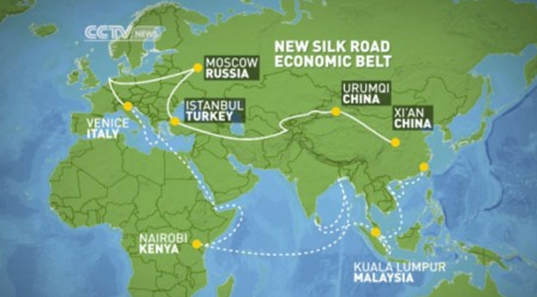China’s Belt and Road Diplomacy. Towards Economic Cooperation and Peace

All Global Research articles can be read in 51 languages by activating the Translate Website button below the author’s name.
To receive Global Research’s Daily Newsletter (selected articles), click here.
Click the share button above to email/forward this article to your friends and colleagues. Follow us on Instagram and Twitter and subscribe to our Telegram Channel. Feel free to repost and share widely Global Research articles.
***
Address (never given due to technicalities) at the 2023 Belt and Road Forum for Interconnected Land-Sea Development from 17 to 18 May, 2023 in Chongqing.[1]
*
Madame Yue Yanghua, Director General, Secretariat, Silk Road Think Tank Association,
Distinguished Organizers of the Belt and Road Forum,
Distinguished Guests,
My sincerest thanks for the honor of inviting me to be part of this important Forum.
The concept of what was originally called the “Silk Road Economic Belt” was announced in September 2013 during a state visit by President Xi Jinping to Kazakhstan.
However, I first learned about this extraordinary initiative when President Xi visited in March 2014 the Port of Duisburg in Germany, one of the world’s most important inland ports. The Belt and Road is a modern version of the ancient Silk Road of more than 2100 years back. I was – and still am – impressed beyond words.
The Duisburg event’s highlight was when a fully-loaded train originating from Chongqing, China slowly pulled into the Duisburg railway station — the ending point of the Chongqing-Xinjiang-Europe International Railway, connecting Asia and Europe, going through Xinjiang and Eurasia and terminating in Europe.
This had a significant symbolic meaning – linking regions and countries through joint infrastructure projects is a means of common development between and among countries in a myriad of sectors that benefit the local economies, local communities and people. It is a strategy for peaceful cooperation and cohabitation.
On the Duisburg occasion, President Xi Jinping said,
“The initiative of building the Silk Road Economic Belt, proposed by China, follows a philosophy of common development and common prosperity. It aims to link the two big markets of Asia and Europe together, giving new substance of the time to the ancient Silk Road, and benefit the people along the Road.”
He was right.
Although the target date for completion of the BRI is 2049, coinciding with the centennial celebration of the People’s Republic of China, the BRI’s potential in time and space is almost endless.
By January 2023, 151 countries had signed up to the BRI. The participating countries include almost 75% of the world’s population and account for more than half of the world’s GDP. In addition, many national and international organizations are also members of the New Silk Road Initiative.
In 2018, the B&R Initiative was included in China’s Constitution.
Today, the Belt and Road forms a central component of President Xi’s “Major Country Diplomacy” strategy, meaning for China to assume a more important leadership role in international affairs.
The Belt and Road is also China’s “grand political-economic project”.
The combination of diplomacy and economic cooperation is a formidable tool for promoting peace and for bringing about more harmony and equilibrium to a world plagued by conflict.
“Diplomacy” as an integral part of the Belt and Road, has already been demonstrated in recent times, including by President Xi’s visit to the Middle East, where he recently managed bringing together two feuding neighbors, Saudi Arabia and Iran.
The two countries re-established diplomatic relations and, hopefully, an added and important benefit of this Chinese initiative may be the end of the atrocious war between Saudi Arabia and Yemen. Mind you, this war is a proxy war carried out by the Saudis on behalf of Washington and London. Yet, there is hope, thanks to China.
Already years ago, when I was still working with the World Bank, high-level country officials mainly in Africa and the Middle East told me that they prefer by far dealing with China and Russia, then with the ever conflictious west, referring to the United States and Europe.
With her colonial past – in many ways still ongoing today – Europe does not have the best reputation in the Global South.
Today, China’s drive for international diplomacy is already an important element of the Belt and Road. It is a Peace Initiative that no super-power has broached in the last century. China has already removed divisions between several Middle Eastern countries, that were remnants from colonial times, or more recently, of western instigated wars and conflicts.
What President Xi calls “a bid to enhance regional connectivity and embrace a brighter future” is already happening.
The Silk Road Economic Belt has already established several routes of connectivity. Three land routes – the northern Trans-Siberian Route, the central Khorasan Route, and the southern Karakoram Route. In addition, there are several Sea Routes, the Arctic Route, the Gulf Route, the Red Sea Route, and the Swahili Coast Route, connecting East Asia with Eastern Africa.
Maritime routes are also in the process of connecting China with Latin America. While China is Brazil’s primary trading partner, Brazil, so far, has abstained from signing on to the BRI.
On the other hand, in February 2022, Argentina joined the BRI, signing a memorandum of understanding with China.
By the end of 2022, seven countries in South America participated in the Belt and Road: Venezuela, Ecuador, Peru, Bolivia, Chile, Argentina and Uruguay.
As of March 2022, 215 cooperation agreements had been signed with 149 countries and 32 international organizations.
By March 2023, a mere ten years after it was launched, BRI had already created more than 420,000 jobs, and lifted 40 million people out of poverty.
Various World Bank studies estimate that the Belt and Road may boost trade flows in participating countries by more than 4%, and cut global trade costs by about 1%.
According to London-based Center for Economic and Business Research, BRI is likely to increase the world GDP by US$7.1 trillion equivalent per year by 2040. The CEBR also estimates that benefits will be “widespread” since improved infrastructure reduces “frictions that hold back world trade”.
With such brilliant predictions, it is likely that more countries will be attracted to join the New Silk Road. Even against objections and opposition from the west, the prospects for a worldwide success story for peace and prosperity through the New Silk Road are superb.
Observing the world today from a distance, it looks like the west with its multiple wars and constantly instigated conflicts is on a steady course of destruction, while China with her Belt and Road is constructing, building alliances, and promoting peace, prosperity, and diplomacy throughout the world.
Thank you.
*
Note to readers: Please click the share button above. Follow us on Instagram and Twitter and subscribe to our Telegram Channel. Feel free to repost and share widely Global Research articles.
Peter Koenig is a geopolitical analyst and a former Senior Economist at the World Bank and the World Health Organization (WHO), where he worked for over 30 years around the world. He lectures at universities in the US, Europe and South America. He writes regularly for online journals and is the author of Implosion – An Economic Thriller about War, Environmental Destruction and Corporate Greed; and co-author of Cynthia McKinney’s book “When China Sneezes: From the Coronavirus Lockdown to the Global Politico-Economic Crisis” (Clarity Press – November 1, 2020).
Peter is a Research Associate of the Centre for Research on Globalization (CRG). He is also a non-resident Senior Fellow of the Chongyang Institute of Renmin University, Beijing.
Note
[1] Visa could not be secured in time.
Featured image is from iStock


